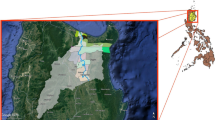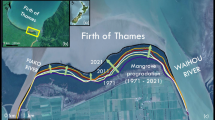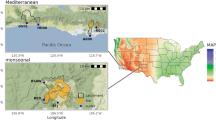Abstract
Timber was harvested on South Fork of Thomas Creek, White Mountains of Arizona, USA, for the first time in 1978–1979. This caused significant increases in annual flow volumes and annual instantaneous peak flows. North Fork remained untouched, but both streams were in disequilibrium before harvest time. Due to wetter years during the postharvest period, North Fork also experienced some flow increases, but the difference was not significant. Flow increases cause increased erosion in disequilibrium channels. While in South Fork channel cross sections enlarged by 10% since preharvest time, those in North Fork enlarged by only 2.5%. The number of knickpoints tripled in South Fork, which was about double that in North Fork. Knickpoint development resulted in destruction of the natural control structures (log steps and transverse gravel bars) in South Fork (47%), while in North Fork they increased by 23%. Knickpoints are scarps on the channel bed that have the appearance of gully headcuts. The tripling of the number of knickpoints signifies that adjustment processes of the bed profile are intensified drastically in South Fork. The geomorphic changes signify that due to increases in discharge, the extent of disequilibrium is exacerbated in South Fork. Yet, volumes of erosion are relatively small, as will be sediment volumes leaving the watershed at a given time, because of the stepwise sediment transport occurring in this ephemeral stream.
Similar content being viewed by others
Literature Cited
Chorley, R. J., and B. A. Kennedy. 1971. Physical geography: A systems approach. Prentice-Hall, London. 370 pp.
Gottfried, G. J. 1989. Effects of patch clear cutting on water yield improvement and in timber production in Arizona mixed conifer watershed. PhD dissertation. University of Arizona, Tucson, Arizona. 184 pp.
Graf, W. L. 1977. The rate law in fluvial geomorphology.American Journal of Science 277:178–191.
Heede, B. H. 1975. Mountain watersheds and dynamic equilibrium. Pages 407–420in Proceedings of the watershed management symposium, ASCE, Irrigation and Drainage Division, 11–13 August 1975. Logan, Utah.
Heede, B. H. 1976. Equilibrium condition and sediment transport in an ephemeral mountain stream. Pages 97–102in Hydrology and water resources in Arizona and the Southwest, volume 6: Proceedings of the 1976 Meeting of the Arizona Section, American Water Resources Association and Hydrology Section, Arizona Academy of Science, 29 April–1 May 1976. Tucson, Arizona.
Heede, B. H. 1977. Influence of forest density on bed load movement in a small mountain stream. Pages 103–107in Hydrology and water resources in Arizona and the Southwest, volume 7: Proceedings of the 1977 Meeting of the Arizona Section, American Water Resources Association and Hydrology Section, Arizona. Academy Science, 15–16 April 1977. Las Vegas, Nevada.
Heede, B. H. 1981. Dynamics of selected mountain streams in the western United States of America.Zeitschrift für Geomorphologie 25(1):17–32.
Heede, B. H. 1984. The evolution of salmonid stream systems. Pages 33–37in Proceedings of the wild trout III symposium, 24–25 September 1984. Yellowstone National Park, Wyoming.
Heede, B. H. 1987. Overland flow and sediment delivery five years after timber harvest in mixed conifer forest, Arizona, USA.Journal of Hydrology 91:205–216.
Heede, B. H., and R. M. King. 1991. State-of-the-art timber harvest in an Arizona mixed conifer forest has minimal effect on overland flow and erosion.Hydrological Sciences Journal (in press).
Hibbert, A. R. 1981. Opportunities to increase water yield in the Southwest by vegetation management. Pages 223–230in Interior West Watershed Management: Proceedings of a symposium, Spokane, 8–10 April 1980. Washington State University, Pullman, Washington.
Megahan, W. F., and R. A. Nowlin. 1976. Sediment storage in channels draining small forested watersheds in the mountains of central Idaho. Pages 4-115–4-126in Proceedings of the Third Federal Inter-agency Sediment Conference, 22–25 March 1976. Denver, Colorado.
Rich, L. R., and G. J. Gottfried. 1976. Water yields resulting from treatments on the Workman Creek experimental watersheds in central Arizona.Water Resources Research 12:1053–1060.
Rich, L. R., and J. R. Thompson. 1974. Watershed management in Arizona's mixed confier forests: The status of our knowledge. USDA Forest Service Research Paper RM-130. Rocky Mountain Forest and Range Experiment Station, Fort Collins, Colorado.
Schumm, S. A. 1973. Geomorphic thresholds and the complex response of drainage systems. Pages 299–310in M. Morisawa (ed.), Fluvial geomorphology. Publications in Geomorphology, State University of New York, Binghamton.
Schumm, S. A. 1977. The fluvial system. John Wiley & Sons, New York. 338 pp.
Thornes, J. B. 1979. Processes and interrelationships, rates and changes. Pages 378–387in Process in geomorphology. C. Embleton and J. Thornes (eds.), Halsted Press, New York.
Troendle, C. A., and R. M. King. 1987. The effect of partial and clearcutting on streamflow at Deadhorse Creek, Colorado.Journal of Hydrology 90:145–157.
Wilson, L. 1968. Dynamic geomorphology. Pages 297–301in R. W. Fairbridge (ed.), The Encyclopedia of Geomorphology. Dowden, Hutchinson and Ross, Stroudsburg, Pennsylvania.
Author information
Authors and Affiliations
Rights and permissions
About this article
Cite this article
Heede, B.H. Response of a stream in disequilibrium to timber harvest. Environmental Management 15, 251–255 (1991). https://doi.org/10.1007/BF02393856
Issue Date:
DOI: https://doi.org/10.1007/BF02393856




